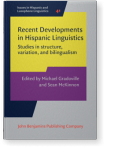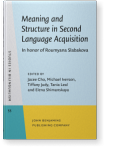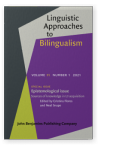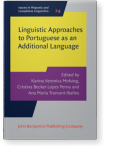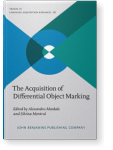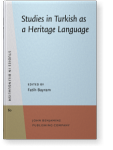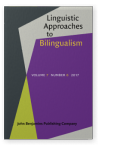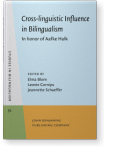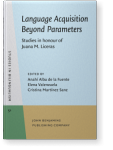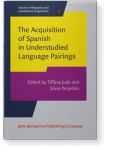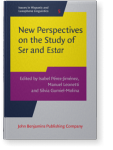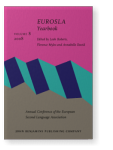Michael Iverson
List of John Benjamins publications for which Michael Iverson plays a role.
Book series
Title
Meaning and Structure in Second Language Acquisition: In honor of Roumyana Slabakova
Edited by Jacee Cho, Michael Iverson, Tiffany Judy, Tania Leal and Elena Shimanskaya
[Studies in Bilingualism, 55] 2018. xv, 311 pp.
Subjects Language acquisition | Multilingualism | Syntax | Theoretical linguistics
2021 Retrodiction in science: With great power comes great responsibility Epistemological issue: Sources of knowledge in L3 acquisition, Flores, Cristina and Neal Snape (eds.), pp. 84–88 | Commentary
2020 The roles of L1 Spanish versus L2 Spanish in L3 Portuguese morphosyntactic development Linguistic Approaches to Portuguese as an Additional Language, Molsing, Karina Veronica, Cristina Becker Lopes Perna and Ana Maria Tramunt Ibaños (eds.), pp. 11–33 | Chapter
This study explores the rate of L3 development among learners that transfer their L1 versus L2, via examination of differential object marking (DOM) by English/Spanish bilingual learners of L3 Brazilian Portuguese (BP). At the L3 initial stages, L1 English/L2 Spanish and L1 Spanish/L1 English… read more
2020 Chapter 5. The distribution of Differential Object Marking in L1 and L2 River Plate Spanish The Acquisition of Differential Object Marking, Mardale, Alexandru and Silvina Montrul (eds.), pp. 133–160 | Chapter
This study examines Differential Object Marking (DOM) in native and largely naturalistic near-native L2 River Plate Spanish speakers (L1 Persian). Persian and Spanish mark certain direct objects (DO). Most syntactic descriptions of Spanish claim [+animate,+specific] DOs are marked while in Persian,… read more
2020 Chapter 4. The effects of heritage language experience on lexical and morphosyntactic outcomes Studies in Turkish as a Heritage Language, Bayram, Fatih (ed.), pp. 63–84 | Chapter
In heritage language (HL) bilingualism, recent work has focused on understanding the dynamic effects that different input types can have on heritage language development and outcomes (e.g., Bayram et al., 2017; Kupisch & Rothman, 2018; Polinsky, 2018; Putnam & Sanchez, 2013; Karayayla & Schmid,… read more
2018 Introduction Meaning and Structure in Second Language Acquisition: In honor of Roumyana Slabakova, Cho, Jacee, Michael Iverson, Tiffany Judy, Tania Leal and Elena Shimanskaya (eds.), pp. ix–xv | Introduction
2017 Subtle aspectual differences in the L2 acquisition of German: The case of the present tense and pseudo-progressive am + infinitive and beim + infinitive constructions Cross-linguistic Influence in Bilingualism: In honor of Aafke Hulk, Blom, Elma, Leonie Cornips and Jeannette Schaeffer (eds.), pp. 207–230 | Chapter
We examine the acquisition of progressivity in the German simple present tense (GPT) and related constructions by English natives of L2 German, under the guise of the Feature Reassembly Hypothesis. German lacks an explicit gerundial form; the AM + infinitive (am) and BEIM + infinitive (beim)… read more
2016 Not just algunos, but indeed unos L2ers can acquire scalar implicatures in L2 Spanish Language Acquisition Beyond Parameters: Studies in honour of Juana M. Liceras, Alba de la Fuente, Anahí, Elena Valenzuela and Cristina Martínez Sanz (eds.), pp. 125–145 | Article
This study examines interpretation of scalar implicatures (SI) in the L2 Spanish of native English advanced learners. Spanish is especially interesting since, unlike English, it has two indefinite determiners, unos and algunos, which ostensibly map to English some. However, each does not allow an… read more
2015 Object Drop in L2 Spanish, (Complex) Feature Reassembly and L1 Pre-emption: Comparing English, Chinese, European and Brazilian Portuguese Learners The Acquisition of Spanish in Understudied Language Pairings, Judy, Tiffany and Silvia Perpiñán (eds.), pp. 257–280 | Article
L2 learners from different L1s may differ in L2 development and ultimate attainment for the same target property. Examining object drop in L2 Spanish, we maintain that performances of distinct L1 groups (English, Chinese, Brazilian and European Portuguese) are not as contradictory as they first… read more
2015 Eventive and stative passives and copula selection in Canadian and American Heritage Speaker Spanish New Perspectives on the Study of Ser and Estar, Pérez-Jiménez, Isabel, Manuel Leonetti and Silvia Gumiel-Molina (eds.), pp. 267–292 | Article
Spanish captures the difference between eventive and stative passives via an
obligatory choice between two copula; verbal passives take the copula ser and
adjectival passives take the copula estar. In this study, we compare and contrast
US and Canadian heritage speakers of Spanish on their… read more
2008 Interface vulnerability and knowledge of the subjunctive/indicative distinction with negated epistemic predicates in L2 Spanish EUROSLA Yearbook: Volume 8 (2008), Roberts, Leah, Florence Myles and Annabelle David (eds.), pp. 135–163 | Article
Much recent research in SLA is guided by the hypothesis of L2 interface vulnerability (see Sorace 2005). This study contributes to this general project by examining the acquisition of two classes of subjunctive complement clauses in L2 Spanish: subjunctive complements of volitional predicates… read more
